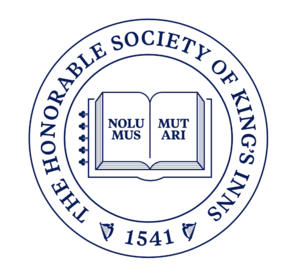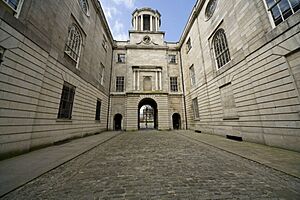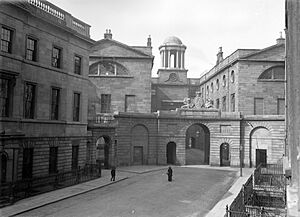King's Inns facts for kids
|
Cumann Onórach Óstaí an Rí
|
|
 |
|
| Type | Inn of Court |
|---|---|
| Established | 1541 |
| Founder | Henry VIII |
| Chairperson | Hugh I. Mohan SC |
| Dean | Eimear Brown |
| CEO and Under Treasurer | Mary Griffin |
| Address |
,
,
D01 KF59
,
Ireland
53°21′10″N 6°16′17″W / 53.35278°N 6.27139°W |
The Honorable Society of King's Inns (Irish: Cumann Onórach Óstaí an Rí) is a special law school in Ireland. It is known as the "Inn of Court" for people who want to become barristers in Ireland. A barrister is a type of lawyer who speaks in court. King's Inns was started in 1541, making it Ireland's oldest law school. It is also a very important historical place in Ireland.
The leaders of King's Inns, called the Benchers, give out a special law degree. This degree, called "barrister-at-law," is needed to become a barrister in Ireland. King's Inns not only trains future barristers but also offers courses to many other people. These courses are for those with legal backgrounds and those without. They cover different areas of law and are often part-time, making them easier to attend.
Contents
History of King's Inns
King Henry VIII of England officially started the King's Inns society in 1541. This was 51 years before Trinity College Dublin was founded. This makes King's Inns one of the oldest professional and educational places in the English-speaking world. The founders named the society to honor King Henry VIII and his new Kingdom of Ireland.
At first, the society was in an old church building in Dublin. They also got land near the River Liffey called "Blackfriars."
The society stopped working for a while but started up again in 1607. They lost their first building twice. Once in the late 1500s and again in the mid-1700s. In the 1780s, they got their current location on Constitution Hill.
In 1790, the land where they first were was used for the Four Courts building. The first stone for the current King's Inns building was laid on August 1, 1800. James Gandon, a famous architect, designed the building. His student, Henry A. Baker, finished the building. A nearby street was even renamed King's Inns Street.
For a long time, King's Inns was more like a club than a school. Irishmen who wanted to be barristers usually studied in London. It was only from the mid-1700s that King's Inns began to offer law courses.
Some historians say that King's Inns was used by the ruling power to control Irish lawyers. This is because they did not allow Catholics to practice law until the late 1700s. This changed when old laws, called Penal laws, were removed.
When Ireland was divided into two parts between 1920 and 1922, King's Inns hoped to stay united. They wanted to keep training lawyers for all of Ireland. But in 1926, a separate law school was set up in Northern Ireland. This new school trained lawyers for the Bar of Northern Ireland. In 1929, it became a rule that you had to know the Irish language to join King's Inns.
About King's Inns
King's Inns usually stays out of current events in Ireland. However, it became well-known in 1972 because of money problems. They had to sell many non-legal books from their library. The library collection started in the late 1700s. Many of these books were very old and important for history and culture. Selling them was seen as a big loss for Ireland's heritage. The library had also received money from the Irish government since 1945 to take care of the books.
King's Inns teams have often won the Irish Times National Debating Championship. In 2010, they won the European Universities Debating Championships. In 2006, the King's Inns hurling team won the Fergal Maher Cup in their very first year.
The Hungry Tree is a famous tree on the King's Inns grounds. It is a London Plane tree that has grown around a park bench. You can find it near the south gate.
Architecture and Facilities
The King's Inns buildings are located near Henrietta Street in Dublin. They are a great example of neo-Classical architecture. This style uses ideas from ancient Greek and Roman buildings. The complex is an important part of Dublin's beautiful old buildings.
Building Design and Start
The famous architect James Gandon first designed the buildings. He also designed other important Dublin buildings like the Custom House and Four Courts. Building started on August 1, 1800. The first stone was laid by Lord Chancellor John FitzGibbon.
Gandon's first plan had two buildings side-by-side. They were connected by a narrow bridge-like part at the front. This part had three openings and a small dome on top. A dome is a rounded roof, often supported by columns.
Gandon left the project in 1808 because of delays and money issues. His helper, Henry A. Baker, took over. He finished the buildings by 1816.
Later Changes and Additions
The buildings were made bigger in the mid-1800s. In 1846, architect Frederick Darley added three sections to the north side. In 1849, Jacob Owen added three sections to the south side. These new parts were built to hold fireproof rooms for records. They also added restrooms, a carpentry shop, and a book binding area.
Special Building Features
The King's Inns buildings are known for their special stone statues. These statues are called caryatids and are made of Portland stone. They look like women holding up the roof. These statues represent ideas like Plenty, Security, and Law. The building also has a copper dome. James Gandon made copper domes popular in Dublin.
Notable alumni and academics
- Henry Grattan (1746 - 1820)
- Bartholomew Thomas Duhigg (1750?–1813)
- Theobald Wolfe Tone (1763 - 1798)
- Daniel O'Connell (1775 - 1847)
- Christopher Palles (1831-1920)
- The Baron Carson (1854 - 1935)
- John Redmond (1856 - 1918)
- Patrick Pearse (1879 - 1916)
- John A. Costello (1891 - 1976)
- Averil Deverell (1893 - 1979)
- Frances Kyle (1893 - 1958)
- V. V. Giri (1894 - 1980)
- Jack Lynch (1917 - 1999)
- Liam Cosgrave (1920 - 2017)
- Charles Haughey (1925 - 2006)
- Mella Carroll (1934 - 2006)
- Catherine McGuinness (1934 - )
- Mary Robinson (1944 - )
- Mary Laffoy (1945 - )
- Susan Denham (1945 - )
- John Bruton (1947 - 2024)
- Mary Irvine (1956 - )
- Hazel Chu (1980 - )
See also
- Northern Ireland Inn of Court
- Inns Of Court



